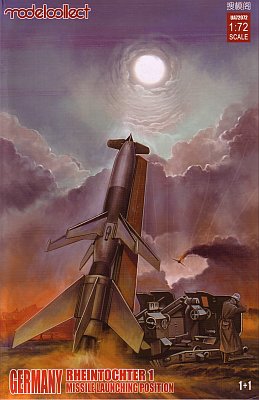|
Rheintochter was one of a number of guided surface-to-air missiles under development in Germany during World War Two.
Started in late 1942 by the German Army (Heer), by August 1943, some 82 test firings were made. The operational version was
intended to be fired from a ramp or converted 8.8cm Flak 41 gun mount. Unfortunately performance was not up to spec and the project was cancelled
in February 1945 in favour of competitor's rockets.
The Kit
Model Collect has been releasing, as well as announcing, forthcoming releases of some interesting kits of late. Among them is this kit of the Rheintochter R1 SAM.
The box top states this is a 1+1 kit, so you get two missiles and their respective launchers. There are 4 sprues,
2 each for the missiles (sprue K with 33 pieces) and two each for the Flak 41 mounts (sprue N with 13 pieces). No decals or photo-etch are included.
Build instructions cover 5 steps. There are two pages of artwork with two different colouring options, though in reality there is only a single colouring suggestion
for the missile (for prototype missiles) with two alternate colourings, either panzer grey or yellow, for the launcher. Paint call outs are for Ammo of Mig paints.
Moulding is excellent with next to zero flash and no low spots. There are some ejector pin marks, most seem to be located on inner surfaces of the Flak 41 launcher, so
they should be inconspicuous once the parts are assembled. Detail is crisp. The larger parts have no alignment pins so care will be needed to join pieces and avoid
steps or large seams.
Some observations:
- The 8.8cm Flak 41 launcher is much too simplified. To start with, the carriage levelling pads are moulded directly to the
underside of the legs. Then there is a complete lack of hooks and their supports for hanging the mount on a trailer, and the legs lack hinges for folding backward
for towing. It also appears that some of the operator positions are missing their seats and hand wheels.
Addendum 1: Al Magnus 2023/Oct/18
Outside of a decent launch rail, Model Collect's missile's launch platform is a complete fabrication. While the kit's mount is square shaped with 4
fixed arms at the corners, the real mount is
closer to that of a kite shape, with two fixed legs plus two fold-able legs for travelling. The difference is apparent in the photos below, the left one being the
correct shape as found in the Bronco 1/35 scale kit, whereas the right photo shows the Model Collect version.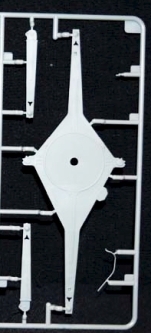
Bronco 1/35 mount | 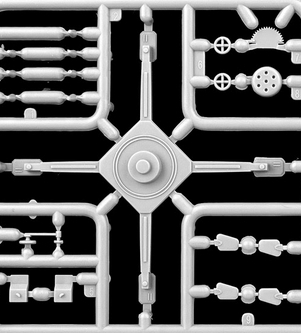
Model Collect 1/72 mount |
As for the operators' stations, the fore one is completely absent, with only the aft one supplied, and even at that, it's not very inaccurate.
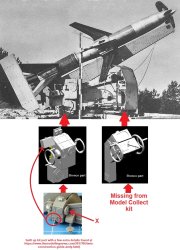
- The underside of the cross mount is hollow, so it needs to be covered over. As for the blast deflector, I could not find a picture
showing one installed, so I think this could be left off.
Addendum 2: Al Magnus 2023/Oct/18
Don't bother covering over the underside of the mount as it's completely inaccurate and the effort would be a waste of time.
- Part N13 is not used and not marked as unused on the parts layout diagram on page two of the instructions. I think this
part is used on Model Collect's Rheintochter mounted on the E50 tank chassis release (kit no. UA72031).
Addendum 3: Al Magnus 2023/Oct/18
So, seeing as the mount is completely inaccurate, one could attach the upper mount to one of the supplied, but not used, circular bases (part N13) and posit that the
missile is part of a static position. The operator stations would still need correcting though.
- Parts N1 & N2, which are side boards on the rear fins, are suspect. They look more like a fence gate and not anything
like the ones seen in period photos, which appear to be more like solid plywood sheeting. Below left shows the side boards on the real missile, and below right shows
the kit's representation. As you can see, they're not even close! That leaves the builder with the option of building new scratch built boards or,
replacing them with braces between all four booster fins, as seen on surviving museum examples.
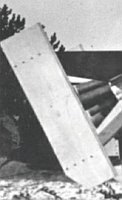

- All of the fins are exquisitely molded. Hopefully they will sit properly on the missile's body. If not, then it looks
like there may be a lot of work filling gaps.
- The small rocket nozzles that ring the second stage body between the large fins are represented as indistinct nubs.
These would be best removed and replaced with new nozzles.
- A pair of the mid fuselage fins have flares which will need their ends drilled out.
Dimensions:
My references have differing lengths for the Rheintochter, primarily due to measurements being taken between reference different points. I decided to use what
looks to be an original German drawing found in [3]. This states a length of 5.785 metres (1/72 = 3.16in) from tip of the nose to end of the rocket nozzles.
I couldn't read the diameter on the drawings and settled on a diameter of .510 metres (1/72 = 0.28in) given in the book's summary table.
Since my model's parts are still
on their sprues, I could only get a rough idea of the rocket's length by measuring its constituent parts - body (part K12/K13), end cap (part K8) and rocket
nozzle (part K7) - and add them together. My dial caliper gives me 2.85in + 0.08in + 0.19in respectively, for a sum of 3.12in for the body, and 0.29in for diameter. A
difference of -0.04in in length and +0.01 in diameter makes the rocket quite close to 1/72 in my opinion. I can only assume that once the fins added, and the
launcher built, everything will remain close to 1/72 scale.
Conclusion
Overall, this looks to be an excellent kit and one worth its value. Only time will tell how well the parts fit together and if there will be problems
with gaps between body and fins, which is a common issue with the many rocket kits I've built in the past. I think Model Collect missed
a golden opportunity to make this kit a stand out, for if they had only put in a little extra effort
and included an R3 missile (looking very much like a slightly lengthened second stage of the R1 rocket) in the set, the modeller would have had two interesting
missiles to build, both using the common launcher. But on the plus side, you do have an extra rocket for making trades with.
Conclusion Addendum: Al Magnus 2023/Oct/18
The only accurate parts of this kit are the missile and its launch rail. The remainder of the launcher is pure fantasy, lacks detail and accuracy, and would
be best tossed in the garbage bin.
The Build: Al Magnus 2024/Dec/03
As the launcher is mostly garbage, I took my own advice and tossed all its parts into my spares box. Then I proceeded to assemble only
the missile, as follows:
- Removed the moulded on second stage rocket nozzles, then drilled a hole to accept replacement nozzles made from pieces
- Drilled out flare openings found at the end of the two mid-body fins on the second stage
- There is an alignment tab present on the booster rocket's nozzle end cap (part K8) to fit into a slot on the body. Unfortunately
Model Collect forgot to add the corresponding slot to the body. To aid installation post-painting, I added a short section of plasic tube to the backside
of the end cap
- The lack of alignment aids for the booster rocket's nozzles is vexing. Using
slow setting liquid glue allowed me to align and adjust the nozzles to the center line as necessary while the glue dried
- I didn't bother with using or replacing the side boards mounted on the booster's rear fins
- The stems on the nose steering fins (part K9) are too long and make them sit too far from the nose cone. I just left
them as they were. Others might wish to reduce their length.
- As mentioned above, the launcher is a total waste of plastic, so I chose to construct a scratch built stand to hold the rocket
References
[1] German Secret Weapons of World War 2, I.V. Hogg, ARCO Publishing Co., New York, NY SBN: 668-0-2337-6
[2] The Illustrated Encyclopedia of the World's Rocket & Missiles, Bill Gunston, Salamander Books 1979 ISBN: 0861010299
[3] German Guided Missiles, Heinz J. Nowarra, Schiffer Military History, Atglen, PA 1993 ISBN: 0-88740-47-58
[4] germanluftwaffe.com (defunct)
[5] wikipedia
Preview sample purchased by the author.
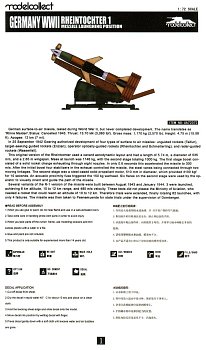
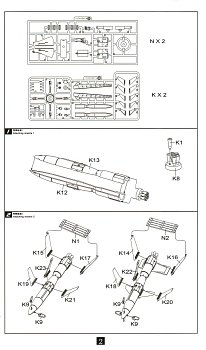

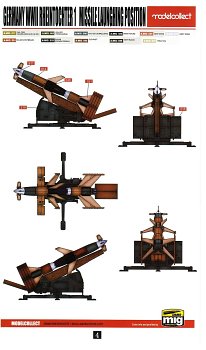



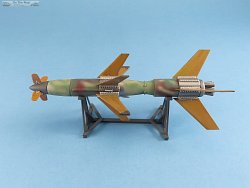
|
